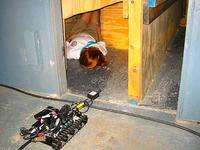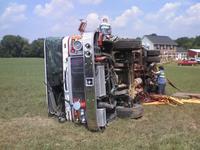-
Robots help evacuate buildings, search for trapped people

Two Georgia Tech engineers designed an emergency robot to help people evacuate buildings in an emergency; they say that emergency robots pacing the hallways and instructing people how to get to the emergency exits is a better solution than static emergency instructions placed on the wall; the robots will also search for injured or trapped people who failed to evacuate the building
-
-
Twitter and natural disasters: lessons from Japan
Researchers from Kobe City University of Foreign Studies surveyed and questioned Twitter users and tracked updates from people in the disaster-struck area on the social media site two weeks after the Tohoku earthquake and devastating tsunami of 11 March; Twitter was the only functioning communication tool immediately after the earthquake; the researchers found that there benefits for using Twitter, such as bringing information to people involved in a disaster and to those hoping to hear news; there was a downside, though: Twitter helped spread unverified rumors and misinformation, causing people to panic in areas where there was no reason to panic, thus making the work of rescuers and service authorities more difficult; one solution: have the government itself use Twitter to offer reliable information to all involved
-
-
Disaster-zone phone communication software available for free
Australian researchers developed software which enables mobile phones to communicate during a disaster; it will be freely available to the public by the end of the year thanks to the support of the Dutch NLnet Foundation; the software can be used on compatible mobile phone handsets to create an alternative “network” where conventional mobile phone coverage has been destroyed or does not exist
-
-
Robot swarm to aid rescue teams
A new system of autonomous flying robots being developed at the Federal Institute of Technology in Lausanne (EPFL) could establish wireless communication networks to aid rescue teams in the event of a disaster
-
-
Smart traffic system to reduce first responder deaths

Nearly 13 percent of the firefighters and police officers who die in the line of duty are killed in vehicle-related incidents, and fire trucks are involved in 10 times as many collisions as other heavy truck; University of Arizona researchers have teamed up with the Maricopa County Department of Transportation (MCDOT) to create a system that will make intersections safer for emergency responders and the general public
-
-
Madison County, IL receives $260,000 in DHS grants
Two fire departments in Madison County, Illinois were recently awarded more than $260,000 in federal grants; the grants come as part of DHS’ Assistance to Firefighters program and goes toward the purchase of new safety gear and firefighting equipment; the Wood River fire department will receive $223,556 to help pay for a high-volume foam monitor as well as foam that will be used to put out chemical fires; the Rosewood Heights Fire Protection District will receive $37,050 to procure thirty sets of new protective fire suits
-
-
SC fire departments awarded $5.5 million DHS grant
Thirty-six South Carolina fire departments had been awarded DHS grants totaling $5.5 million to pay for new programs and equipment; the funds will be spent on 200 vehicle radios, 200 walkie-talkies, and 700 pagers for 36 fire departments in Spartanburg County
-
-
Growing suicide trend poses risk to first responders
In a growing trend, people in the United States are increasingly using dangerous chemicals to commit suicide; this trend puts first responders at risk by exposing them to deadly chemicals; in 2008 a Japanese girl released fumes that sickened ninety people in a chemical suicide attempt; responding to these suicide attempts is also costly as hazmat team materials are expensive to replace and removing contaminated vehicles requires hiring a private company
-
-
CIA forms taskforce to assess fallout from 250,000 leaked U.S. cables
The CIA has formed a task force to assess the impact of 250,000 leaked U.S. diplomatic cables; the group will scour the released documents to survey damage caused by the disclosures; the name of the task force is WikiLeaks Task Force, or WTF for short; WTF is more commonly associated with the Facebook and Twitter profiles of teenagers, where the acronyms stand for three words used to express extreme disbelief or annoyance
-
-
Unease grows as Chinese telecom behemoth gains foothold in U.S.

China’s Huawei Technologies — a company linked to the People’s Liberation Army, and which has been repeatedly accused of stealing software designs and infringing on patents — is now the world’s second-largest telecom equipment supplier behind Ericsson of Sweden, and with Chinese government backing, it has sewn up major deals in Asia, Africa, and Latin America; a $3 billion in advanced wireless equipment deal with Sprint Nextel will give entry into the U.S. communication market — and this has lawmakers and security experts worried
-
-
Spray-on skin to be commercialized
Sheffield, U.K.-based Altrika set to produce a spray version of its Cryoskin donor skin cell product that can be applied in hospitals outside of a sterile surgical environment in order to reduce treatment time; the spray would be stored in individual doses so the right number of skin cells can be selected once the wound is assessed; the cells would then be thawed as the patient is being prepared
-
-
Collaborators sought for emergency communications network demo
NIST and NTIA are seeking partners in the telecommunications industry to help create a demonstration broadband communications network for the U.S. emergency services agencies; the demonstration network will provide a common site for manufacturers, carriers, and public safety agencies to test and evaluate advanced broadband communications equipment and software tailored specifically to the needs of emergency first responders
-
-
Initial tests for buried victims rescue device completed
New victim detection device has been developed as part of a project aiming to enable people to be found quickly from under collapsed buildings or from natural elements like mud or snow; the detection device could literally be a lifeline for victims of future earthquakes, landslides, or terrorist attacks
-
-
In era of tighter budget, simulation-based training becomes popular
Training is invaluable, but first responder and emergency management agencies around the country are finding their budgets tighter than ever, and it is becoming increasingly difficult to conduct large-scale training exercises; the solution: simulation-based training
-
-
Indoor locator device for firefighter, first responders on the horizon
After several years of research and slow, halting progress, development of an indoor locator device to be worn by firefighters and other emergency response personnel could reach the production stage next year
-
- All
- Regional
- Water
- Biometrics
- Borders/Immig
- Business
- Cybersecurity
- Detection
- Disasters
- Government
- Infrastructure
- International
- Public health
- Public Safety
- Communication interoperabillity
- Emergency services
- Emergency medical services
- Fire
- First response
- IEDs
- Law Enforcement
- Law Enforcement Technology
- Military technology
- Nonlethal weapons
- Nuclear weapons
- Personal protection equipment
- Police
- Notification /alert systems
- Situational awareness
- Weapons systems
- Sci-Tech
- Sector Reports
- Surveillance
- Transportation
Advertising & Marketing: advertise@newswirepubs.com
Editorial: editor@newswirepubs.com
General: info@newswirepubs.com
2010-2011 © News Wire Publications, LLC News Wire Publications, LLC
220 Old Country Road | Suite 200 | Mineola | New York | 11501
Permissions and Policies
Editorial: editor@newswirepubs.com
General: info@newswirepubs.com
2010-2011 © News Wire Publications, LLC News Wire Publications, LLC
220 Old Country Road | Suite 200 | Mineola | New York | 11501
Permissions and Policies
